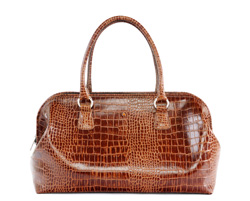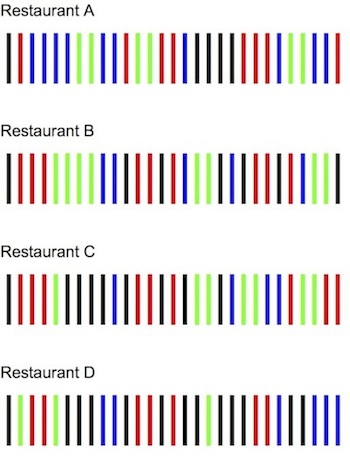Chapter 5. Busting Poachers with DNA Barcoding
Busting Poachers with DNA Barcoding


Read the article below. Then complete the comprehension questions that follow.
DNA check on aisle 7...
Imagine stumbling upon a mystery species in your back yard. Now, imagine if you could take that organism to your local grocery store and scan it like a can of peas. The species name would flash on the screen in a matter of seconds, and you would know for sure that the slimy thing you had found was a newt, not a salamander.
It might seem too sci-fi to be true, but researchers are perfecting a tool that achieves a similar goal. Called DNA barcoding, the emerging biotechnology can distinguish between closely related types of gorilla, crocodiles, and other animals.
Say you have two types of beetle that look nearly identical. Chances are, they share a common gene that contains a species-specific sequence. This sequence is called the DNA barcode region, and it exists in real life. Although unlike the barcodes found on grocery items, we can thank evolution for genetic barcodes.
It took years of trial and error to identify the genetic barcodes. Hundreds of researchers from around the world sequenced DNA from the animals they studied.
In 2003 a meeting was held at the Cold Spring Harbor Lab in Long Island, New York. The purpose: to compare notes on the genetic differences between species and select a region that had enough diversity to use as a DNA barcode. A gene called Cytochrome Oxidase I, or COX-1, eventually was selected.

Unlike many genes, COX-1 doesn’t vary much between individuals of the same species. Any two gorillas will have nearly identical DNA barcodes. But when comparing individuals from two different species—say a gorilla and an antelope, there is a clear difference.
Waiter, there’s an endangered species in my sushi
This has opened up a world of possibilities for those interested in identifying mystery meats. Imagine a customs official trying to evaluate a shipment of crocodile purses, or a police officer busting poachers in a nature preserve. When dealing with processed, treated leather or a slab of meat in a cooler, it’s hard to identify the species of origin. Based on sight and smell, it’s hard to know whether the meat came from an endangered animal like the Kouilou gorilla as opposed to an antelope, which is fair game.
Researchers who use barcoding technology can extract DNA from the sample and sequence the COX-1 gene. Because DNA is such a sturdy molecule, it can be extracted from processed meats and cured skins.
Like a product barcode, DNA barcoding is an emerging biotechnology that is helping scientists distinguish between closely-related species.
Picking the gene

Using a database called Barcode of Life Data Systems (BOLD), researchers next compare the barcode from the confiscated meat to snake, cow, and other COX-1 sequences. If the meat comes from a Nile crocodile (Crocodylus niloticus), its barcode will differ no more than 2 percent from others of its kind. When compared to a piece of chicken—or even another crocodile species—the mystery meat sequence will be 4-10 percent different (or more!)
Researchers also have used this technology to test sushi. After analyzing 68 pieces of sushi from bars in New York City, George Amato, director of the American Museum of Natural History’s Sackler Institute for Comparative Genomics, made a surprising discovery. Most of the fish were mislabeled on the menu. One-third were identified as threatened Northern and Pacific bluefin tuna, while seven samples were southern bluefin, which experts say may soon go extinct.
Experts estimate that wildlife products have a global market of about $15 billion, and more than half of this trade involves illegal species protected by national laws and international policies. Since barcodes are admissible as DNA evidence, Amato is trying to help customs and law enforcement investigators integrate the new technology into their systems.
© 2015 W.H. Freeman and Company
5.1 Comprehension & Application Questions
Answer the following questions to demonstrate your understanding of the article.
Question 5.1
This gene, known by the acronym W5k/GdIKbs8xYCFQs0Z/Yubh1k4= , was chosen by researchers as the best candidate for DNA barcoding of mammals.
Question 5.2
zZ+1wvUOtqwibuJNGpnq2e/GxrY87K4N7JN3Q+F3PBLbxhyJZbt0tkwEwY+kImvXfRYFKUd/pg6FydrWrrxAF0EcQRZjf5aReS7MLRqGjo2Z6ItYcxjcY+Iu/8AMIVdiu64cJIlMn/h8jqK1v47C3HMlHNHp4m/5E6VE9+7ebAqhy40c3N2DZ+FG3WGdPwfL5vqtpHwNOOTINIRwpeQqX3p8tLVhBowoZOVs/IT/S6RHpUEoBIvu4cVssjlP7akJpKp8p9V5kUuUZAX/IJfVfnVePs3RE+TxBCduDyQLS4gQpIBqcwRONWqTuEYX9NvLPFSdo6OQbpDXXqGuBuX10N4ujRu6TT8yWcMzZZXeltQEMYBfGnDYKYHag2bec1DWeR/dJIqjXNdxF1/fj0uSSZOSloidSngToPdmTbbU82TsNGObHH+ghRsDGCKYTlCn/b+4N2RkPzSSS3QrmJmtvsySA4X4EAaw1ziVWZ9GF5iHD5dDu1aDwVwxAH2bdx1BcN94F9efjNfHjT7zpw64uB4ky3YwxpjMr7eG5Sweh0QfO6XqU/I3Q4xVPkAciSavtjfDhFn41mRk/V37V9m0n3l6MV0UdvbPhbg035WJRnwzOeDehCj1RIXAF71lNlcEyS9RdkEeOvXRBGl16VD4YsARiLQwwkcA4xegDzFODDWTHEP+nG018WKnEb7zqm9Uxzn9k5GDhvOrkAMw0SIUKuzLF9dBkOWWaKgOPZFT5flI6mGGRl67qd4k4GfPubjHQ15b9KJPKa/kI1xQ4rE2hxXmQiOlQ5PjwXWki5gcQHRyeEBbdkIuslouqIj+nZK+jQiZFtcO7oKTQupvFnW0XjxQ9Mpmk65wTBhAOJXBU0Uk+mc8KkNIvCxEEyq3Eqd9s5HaCvJMpWqHlRaX9H0Us6v3By6kPRdR2+tWQguRTpDqTb1kuhT4uT5JtIK/PvU2IJZFzKarZt1xQ5GHG0gh9wkwDnWlXqYsttxpoDVeAl7zXWV9TF0psCq2PwBJ6IPfKpzK5ARRINJM3na0LmSzJW7nfZ9Cfr9TxfF3t30bWR4FjOj+EThRekXlPxfm9Slz6vei0g==Question 5.3
r/PqJ3QNU+kwcYqaS6n9aIheFwrrP23YLGvAE0QDhLu6I3f7Nhp+xM03YLIw1GJjwScIT+Wm/M+pKGQNjq0zn8yOnfbTWQXqQi1CH2eBCYjfaFZ7sunFsqci4iEQBlAT16dSyvTCqNoEFMB8dkhE9ETJfIzaCPksrjH4ncfw8T//IKjl1XrhGEqgdtb2VIAXBsbo3cm/18Vwq0x7Jhfc961mW+TtJyRjk3BS8Kf3xJCaM+I4kE4B11SpY0G54mDisAcbvM7gE+EbYZQ4RNF/EN70qUgJs90I/2A2mYnw5UOr0lWtqaHBSDqVf4BMpDL56G93TSIvrnoC++C/JskiOqqISE3KEYceYO9V2f8hUmEn1CM7Np7BhqpePseGith7cD2pRiB5CUSh/OM651tC0Me6dSd3Sn+1cIup98jQ9L5bzDQXjKoD+qxLqDwUdCI5DqWnm4wuqb0BmI7ESx8Ynr0YeYc75yL/6/7KX9qZejmOEP0fHuhaFkkDZbf7/hGtHU8sRI6AxyU+rMBawo1dKBtZArrTYwigWZuraoRNbgN86IXlSWyg261XQ5CDgKg7XCRkAVYn930N3QylriwQOezn6Vcs76MEO/QpKwXFeqTtNE0v2U40B18XlnEs6qQzrm1EtHNOXe4YbzWg2ef3L2swXCI7780iP05gCa9RJFKwNebAIviJR+fT3wxj0kas59fbZ0tsTZMZyu4O9c4yN92OZrmFd1dEyYgMs9cTdoazlK0Qimc54L9ghsk9IHHtYj3cBGUBL9vpZVfyU40Hg7Ff9PJDECCZmkGVKIexJvk6aEuKiRu2bhl6AyzqPxf0KLVK/8FheNvrrcrSFZVvaQPefDAO3APepP4hGRwv6nWtFzNdCcWDA7ynUSmvCfQJ1IgDPDJSc/6XA28TbfPN2mLwFJhKa30mcRpPZ2LuqfQse8i5Z9eExp/EbkXYjfBjjsLdsEAiK9mpAfNtMlgsNNLCz5NMrDJw+ddH4/5wtCD4Ir5ecbJHxfQrtQrdZwBEbD3ZNc1283Ue43Acqm6N0DX9g1QMn0fwiaxPAWL5QE+nl8CsyLonJyQyb+D+hZfV48enNBqu+P40Gq+FvMKIKwqReisfdJeJz+jWuycFmKRxQAuVYd+c7aQhajXuNtLK066+eUuXFTBdaZk8LCRvQEY2vh2e/vCYlPGAYffWw8oEf5vwqsQkJziFCiEEw5qwqQMlDH0S1nclP1AbomaIucUeb9FrXNcVvh1KC43BS61LxZdqI6HWoZAs05Ebo7vAjv/KpAOl60PDs44yGS2HbbdPd/cahSOU02PPNfdD0XWxrTrYbZfjNsuTCJwyZ03Rekrxu9SkRHPx8vU0qnCBI3fvBSLIfK2mC4uZjzir4hkZlrleppgni7y6UBw6WY5IAGcEqPS/8UVWudrWwYPRwJnlDxdaQ87gng3ZYauvPmfhnY7BQTyt9wT/AgUnwvu+n11XiGefds858rEBYXMoHBk3jiH2705JvmhgW0PdBYbupg/Rrjx0dVoewldZxqjnGHAEZPzO3olJhDnjpG7lro1pRTOcrvo8dE951g+fMzwljML49ZyZI6qcEdzEk7+rBwLgKDhrzciK+Fo0o5ylMHE9xEukNAK45eyzVr0ZhQyjqF2J5uyKP6jgjHUNY8mX2QXLTKFFU/2GdGJJG01hIhEE62ySDpNnZc4URfzQ4RIrdRw2r+7j+L0uVzF2rRCZQOPeVTPYIaTtu0ypdSWfO4X6hKRTSVDz4gbCchUUOdgJSSnt1Ba1KLVjj9eLYH3Vbw3unCXfvY1ImPSKhDoPPJnS1fikQlvczx64wRRXWtylYF8PZAlFAkc+ttw/B7/Sx+3jwKXgPwn8aMhRjRe6Sv7hbaY7hy/fTDiW7P3fCfOG2INdv37eJfUIBHODGZxWFhFPDwGKX+dQ8G/D5grYjYy3PyKDOACvVbLhZ0g5lsGGZYAEiFZOva0jwjIsfR4DDqYAmvigeHdQKKmi7mhN2c2uKp1dHnEqU7AgQ0Ii/Q40Z+d+pncGdXAhAIxXeYB7rAcNrycy+hB1g+2c6z2pVA==Question 5.4
True or False: While DNA barcoding is effective for comparing genetic relatedness among living specimens, it is not very effective for testing products such as processed leather goods derived from animals. This is because DNA molecules, which are very fragile, are damaged or destroyed during the leather curing process.
IkLyhbbYRLnR0DDUHGa+YA==
Question 5.5
When analyzing COX-1 sequences, scientists query this database, known by the acronym eyudGyR4df8Q2pWmXb4UQ+98BvA=.
Question 5.6
Fill in the Blank:
Researchers tested szjqm6ZfNSRG+lYU from restaurants around New York City and found that most were selling species of fish that were very different from what was listed on their menus.
Question 5.7
UXEOsJWbJGLsQa3KkQLwXxI6V/wMZzvV1JZKwnupfy7ouVxr3cU+VNQmwpPwh2Y64mMLYTKsLEy53hCCog5zf7miPnD1RU5wWNlaJUECjuPcMznauw6qe+yG/p9qSgXwlMMz0YGuLCcZOEJqmDgL745vL3RiRIpBlIAx1uD9GcC05jhGIdKPGsfrCD0Q9KvTl6vVnxYvhrTqQ0dgKFSo46UYYZDDqei76veRSRfI+o3y4h7sl5pdg7Gol0daM9jGb3MOtQQKO5JJcETn3f+4dxqMJLnRnWHzYRl23qYIhh3hVaE2Tmr8Yu72/Tbo1zoETP5L3LKAy9wONm7wn1Y0H+7x8CNzxvfEleJBtvT0a4Z4WUN0Z1TQpcvv9U0YxDNGbGjLwiiVOBdiNNRA1d22rzY4PtAI3vB+jmEKPfs/eWRkKxbyQNPnhrsb7OIe5uihTG7W28ddJQU5AmwtHYE0sdltiWPXV5GbGcGELDeJV1MrdQIuin3e3NTgJzLGupXGA+SFRLS0Ov5Ra8lbH6H+9U7JCOEWMVNHk50jo6iCoULEIxikBrGxvmqm+Enq2vv4Qm2zADeJBDN3QZKNh0OukgukDtGnckOOBXlcIDxCsM9WLSVa2EtZKHFMfOChU4OvGQ+eSgAW22MxgDMapQj3gyzSBD2d8vLfR3KCqtuE+PmdhEiyJQNU4Tgvany9gueY0ddTWwYCUcikA3XCaE5U3VkgW6b6pK+J8l5wUWd6bKMvfPGW8FZrDz7Yf6lFS6d0ckhDgRKcNoZKIB5oEy4EExvP7kElbsXNs0GiUCwpuZYQFpGrUpcICFadM78hkB8MXHrvbv48vvTnQKTAu0aWWLxE3ikJIxFc8AJLNsSPBVGLu1keAX/6dw1ihHQZjoSQHgbCB9RJXnQCwg5EU2enTuy31KpoWdgXpL7TW508wSXVbvsXq0b0UX/P94DqwOBwb+JAO93zjA9Ghgsdh1rERrbk28RRsR0zuUadvAzsXcK6Y6Ys+GaMcgzy9ZkFnafERRlgd2BZnLPlnfUAYKnVSvk80GDUR1H9CyomUArH/k/9pTs1VlB2de+sEGew3ag0aFrm2olZ+0ZzJJ5Ik5MEs/4OejUUSN7yVwLOrUdvbWOeKlP32YYiXAkd+7EcAWfsHLn+USdKATP+OaLkukDXwxmeLjZw0cPSKpeuhr+zjfUgGCJrNVnzOQ8my4ECRNrdwmEImTvxn57zoyNF5sTo0S//uosXaeEWDAEL9PUGHt2fjh+yZpR0P2aSmCp4Ltxtsp3zqf3lNgxtoDubH+VbGZ1q+kUzQ54HrVKR4UNjKUH9MgiahUAv5vpMTfqDHx4teZTXY6XUFi6Wq+JKd971Jbf9m+An0FsVUD2pgcaWjArfN4dP1LjwwBX1c42aqK4iFTL0AE/19V5exQSNsL/mvxvJ16nhGtQ2MSC28ry5/IP1zeb5oczOT4hcCRyHTNYtt35MLIIkTI751nU892TDvA==Question 5.8
The article notes that global trade of wildlife products is a huge industry. What dollar amount represents the trade of protected/endangered species on the global market?
MBrSEjPJ8lwtIktWdVtqjTNgn0PjLL9oUwXWyIapF0mXJf1C+Ib1ZPTnnV0ecLcUUDQH36EgPqBPupVLJRv1+kxUcnbiprzs3PEWEOnvNEw=
Question 5.9
qNYrspRLV2ohNn0Ub4w8SJf7moZIzq6iWIXuxQtGlN8PoDx+WIRNgZU8AdxUpNtfdbWYQAw8Sw4LK5KpZxAcdWHE4Klv2Y/bKGcYwdrIio7d9mk5Y0ynkRCIdCjQlx10mi77TGHVQWtpLKpiWgp/3JE7vg0EQFoNQ+ZRB0ebFcsyvgyL1ld3ZDYpx3LgnXpH0qVJzfYFJvBgVVFm/mwTG1qGTaO0PCAK2MZEgN+7O6YtxYBFmGuNaePT4AN+cZc1LWh8FyxOPYhQDrVkfPTlWa3ALOrkYcB1CQbRwqc3ZIPU4pFOjEx1zyi4LE8ckN9bERzWV12WPsjwEv99e+kJZyHUKLsaplQKXfjcP08udIWwTPEito7ZcQYIQJf+PxHbm/6891OCMI+xoSn9y/SApOoN8s/DODc1WjMLQ1kQSlmAfTPqIvvvF2UAi8G6RvDVQ37lIGY+nehgW3Gh8cb7MG8UMxFGlj18qcMnCoFOIWB47IhdMtwjYNSQ0CRGW9faKL8rqwyQIFILd2+vlTkwdF/CQ49LZ3oRzKQWI7TdQnuvtgNyQvbK0jdgPm3GqHyoMngT8OZkVZXvxB83oGb9d2y7xOuVKnoEqdOEDpp/Jpf3DGlPx4tB8IMwrZNhQoMfRW6apXQ6wi4vpZbiKKioDqxRnATQ6ZZT5Iw6whU0E7t9kfk0tHCYuqVIN+YCo9SzaieDIcI47GEvkR6+miaOdqzHHsv+7h1a7UIaioaGqma5+REAGwkzWaSk00Dgv/Xrt/yD1ndeyC492bBw/NMBjjD9a7gS2wZg/Pr+5TDh8vu1GTMF4k7k9VBeTxB0zcd0nGA3HTVuyJhNdyUh8btl68GLHeu9U6XA8UKAiM6wOvTGDvXzrE6qC5+hL+G+lOb2d/diHW2iSLdihHX6SY03EBDGYCXcwpqhPWordMa/lj0RnAFNUPO7m6DjFhKehiZrg1wKBZWvAwtoPr7nvTuOPUg8nzpCeSDVAqTYEmhhFpc3dHCR+PddN1GF26/ZQxjfagV81cP4Pqh4le13cbakztYvPS1+TlIvOBoubFpoShGZ4KGM8LoxCXq/ULrSF447a9x/QybW20lBHVWoKU179s0mblAB99OyuT8uyTt2Q7gLykso8pnqDlQ2RYgTX8QZiB36X1nLnTna9VmOaAgraYQ+XQB92JpWlEoBKIxVRtbAuXAa6g+wByUDyo4I84902C9jgNNHaHFk2rXo4IYpsiunCB8wfHExfYNXvHb30tZ+K5FLMhZIN8jQGrHvuSnyM6oECZn5k2zLxnBfnISxjO7EzQpxknKEs5Rk6gmTXLyitQijraCnGqCLhxzvlTkrH/GX9Fi3xehayXmNpXaxqkibuQeXp2R5Biy+9O03NKlQi5ezgQqwUC5SHosK26BbP2hhpOfCpr3phDucsbHPMEQboRHYgxPLpbCwFjZreL/seD/0JOiLtkNZqSc0UsZropIvK0GtygQ1Y149+MAZp/c1fu3sdSW2Ph9t6OUSKzIy0x0bhjk+7uUxpoFDQkuz76wGd2VsWFb4D3a22e09QpvIXaaWfTYPEX7ygiiAZfIhAxz1IRSdOfbWk9NbDq0nVTsJx5bgc3fhm3JilAKe8V5HMBh2MWxWv7EvEtHbRPczoewEqlkrYd49ZwzT1NN+hZkpc6IxSS/oKOF9iNRvLs4W3LveZFp6Y9be5kcLw1x3kkIkvc2XfvhEIV6n7nMf4IhHg/ZhdcZefEuxHq1b8K4iwWL0Z3kqJGRweFVfXg4sGq6YWT4gqoVxzp8hhjoimnBD/cW4pTIswu2HK3VsSU+EFBEYZMIHtMnr3xsqzj6PCIGKeH4dDgJ0/7FeBUAzWZNM8Jtn/g7mCXhCG4opFOScaM2Ks0Kr7QXFxnZ8WXUcQeKIT5JrI1WaPX8OnBEUAs0rZZ1n0BH0hgVKEjUZObaKkTtgw2yL1jNcsqSWVukKvtxkuQaJgjboUTwlbkNHrPRUloxNdGiS0X4BeHWhUVrbv91226LZV9tTpCfiMg3uJFPfdCAuNYXhl2TjUttxFkN0kFk8w+pFIX/xe1j1ecH2aiFF00noqDfjR5rjn3aFjJyYAca/zMflSyHH2vL+iWle3SXxtC0lTKTyDMO0rC5lZ+J6jhn6c0eIugurmLYGjsirMZHjc/tuyXSBaJMDiYPq5BIH9yijWPgDlKMZBGh0gWXGZkSd5Y6vzHrB4dh5026qWozj0kaucpRaXfa60nw+5eMFNKNaS0LzDXWlcVljx0k3UAzIZqhD7XzfH2U6Hylm6uR98aPIb+ljOB/0ZvGH0UhaVJ/NeQURzIx08DXpV/S5+T8IvCrC3IEHC9Y4Oq4VAW2vPnlKS7jh5xwhK6TnaOThQmD2xyS/alHkVWyszSAC38S+UWSLz3Ahdm0O+24C8XsbS90TdRP06zUPyeJ0ZlbltBvSEQTk67uRaB14y4iZEPboUKdF0Web9XscJjxJMqwQe6bJ4dCsLGVFKJr7RNwyfvCkOREVCZThwHIEXH3gySZQH/kSVgEG7Ij97XRob/CH8mRH4aC8uKeDmeeTqAz67IDBT1cIC/ytU+nJ0I24joLcpgQ0fxSyTOK4SpGP7bT38D/in4kw88LZzSBppBndQzUU1BFclimFxh94Ei6NJyXOSc5GJyT4F9+Iv2oihC9sYqkLj3cuuKwzQEJvQjbIhKbst83nagVE0GtWHJXY+80SFBRx2oHeGUdDofCpW71bjyLHP7mHu7aDyDVcenP/ZWv6uugYzy9vMZBIb8jwsHQRxf2YUruzYXJkdzVjychpSTodUPj6aakUu/OkA17blk3YurzPhmW3XPkJVv6YWc/rbG4TWPxupgg3I0zAEAhVYDFzMDVazUuQcgODt1uchw5vHjQWkhGc9rMxeYR31XUiVCmEdvpujmHJEgJooCfOBvnRnbX2TChD7S5tOve5n7vDdEgOHyhu6saqASlt04ouUGu3ArXiUH7fmtoB+8kcdS4gxc9xAAIbzNvozI8oyA2ivDZcWuG+iSSMreYwB/6zMT2HABsc2iRtl+z4Td5Lvfc8YqPhhqavMeyUdh98X4NalKIC4FOtM+YgFd9QUUF9R8jFmQGSOFYoM0bmdOBEwQ/L+Lfs9pzFLeyepaI3jlMfkwkhV41pvuX6dNBSZFu57B7nWDuNITL00UHCLu8U5BETJrG+DmBVgdX3OjZWhlbCzuDBiSPUPKp/OGM5Vy7ATUU3y1MXyX95KxXbc675cki5pBcE/+awYlwOOOtKqcbcvg3RA+z2NqPzbbc2iUMib1UmbNGwb23CSPPixEXf19yIRkQtHyDzsF9B0sCJXwXkZVQP50wJYOaLyC0IlDWNTYa9IgAV7OZQ1iARppMD5s8GCauVSpSgWemtiWldgeOGUheXgDObL5xDOHrzcH/9oCT0XKiQcswwV/nFOTuFmhhNp/14Sc7ICOML2bz+eXDSOuGbie1kRTbv8MSTPKIhLTuIcKJdDw6yw6FqRs1bgxiWynVikLNq4XnJ/sgcvLLqWNHI3PL8s0fE6hD//S/1KBMArGsTZcmBDDfi0j/pnUQpleagT6IBlDw1mlvUIPKr9onjA7VesIU/tc1cRzr/EjCwLQlrK+awkIy7a128aKwwWq9RVYzZUM/DvgHEJcwEFfKmRZJ5fwGyORZiW9M5a3JNHgfxh5qGgYZ6MEYMf1tr1YIpIVoNtcNdcB7uyJJxgW3e19xe41cgDHvLCPeCIRm1BEkKi0mYE1GubLVubOSkEnmWLA8V7KKd4nq3B4r5nhIYSaPrplFnrcVUww7seBf/se8GQbJDkvzGLWFMp8sQ2ouRRw2hfVRIath1g0uJwOn9N9XPkoQ52MxyMeomezqC6QSW6NOsRWLPmCxdSnFYOsZq6PiwOskOp3ZxLx+kYmnRWWiNcN/LurHCJbEMSHrxKR7xs6WDrpzRfcrAYO0avr/ekXcYUH/lg1nKUOGxwWL+vd4ve1K1rUvB39CMIIcncHfjVXOcTJJzIRr11kPzI4esbP7MpMk7zwY0vvKPxBZvnUWieBaLVRQ=
Question 5.10
e3EZSoCdoT3ZNumI0UX+0G8OLu7t2+k+jkrHlQvlQT4XbBDg4YJiYUwr+XPKiwR8d/EYyobvsjVrmwppBPYXqYqu7+rZeRZjZh9T4MPbpdfQ//2tICLue6BbkeMo3fc1J4dG/kqADc0aI1wYS2zQ6c5zmHYp0UOT4+uXJlpp2v1F3j6s2RbthZ841kqDzHkWu18MdcdJU0HBi3Ja5obmCydAxl9uGBR0VKsGGPOsihVobvHbfwzXpgkjU38JVUlhT0DPHPdHxiyTX9yyf2ppDX1vq5VOyTPSjaxhoAROxCCvJQZnVgetF55ZwZzeTXJBAqLcWt7nfWtLtkylACf/eCtM9lJ6hqUzl5PqG4g6G4KOFz2OJfOVyOXTh6e+nHpbVsBD6VjB/QuW346OQ0EQUH/4qs8MyUouCjTCJ13ZARRU42JW20TlftxllTSzsF0FIwH9OsWNuWf89lP+9sfpRuoTWtHHy76IhcfJiAXFXYgGPbQ29RdAiPBPemqmiBUjcYY7tQ==
Activity results are being submitted...